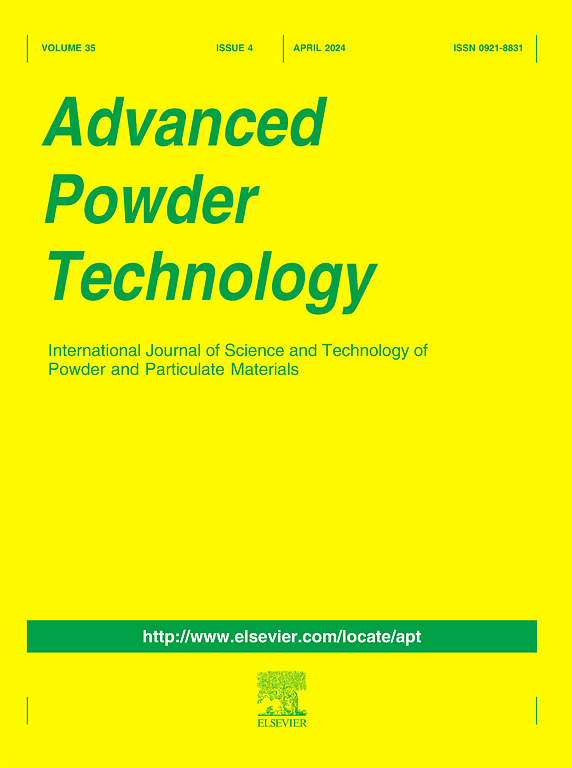Optical characteristics and application of cobalt/nickel doped SrZn2(PO4)2 blue-violet and violet inorganic pigment powders
IF 4.2
2区 工程技术
Q2 ENGINEERING, CHEMICAL
引用次数: 0
Abstract
Blue-violet and violet inorganic pigments, derived from SrZn2-xCox(PO4)2 (0 ≤ x ≤ 1) and SrZn2-xNix(PO4)2 (0 ≤ x ≤ 0.5) solid solutions, were successfully synthesized via a solid-state reaction. The structure, color, optical properties, and potential applications of the synthesized pigments were systematically characterized. All pigments crystallized in a single-phase structure. Rietveld refinement analysis confirmed the successful substitution of Zn2+ by Co2+/Ni2+ in the lattice. Based on the XPS and UV–Vis–NIR analyses revealed that the coloration of Co2+/Ni2+ doped SrZn2(PO4)2 originates from d-d electronic transitions in a tetrahedral coordination environment. Compared to commercial purple pigments, such as Co3(PO4)2 and NH4MnP2O7, the synthesized pigments exhibit superior thermal stability and require lower cobalt or nickel doping levels. Furthermore, 2 wt% of these pigments were incorporated into poly(methyl methacrylate) (PMMA) plastic to form blue-violet and violet composites, whose color and optical properties were systematically analyzed.

钴/镍掺杂SrZn2(PO4)2蓝紫色和紫色无机颜料粉末的光学特性及应用
以SrZn2-xCox(PO4)2(0≤x≤1)和SrZn2-xNix(PO4)2(0≤x≤0.5)固溶体为原料,通过固相反应成功合成了蓝紫色和紫色无机颜料。系统地表征了合成颜料的结构、颜色、光学性质和潜在的应用前景。所有颜料都以单相结构结晶。Rietveld细化分析证实了晶格中Zn2+被Co2+/Ni2+成功取代。基于XPS和UV-Vis-NIR分析表明,Co2+/Ni2+掺杂的SrZn2(PO4)2的显色源于四面体配位环境中的d-d电子跃迁。与Co3(PO4)2和NH4MnP2O7等商用紫色颜料相比,合成的颜料具有更好的热稳定性,并且需要更低的钴或镍掺杂水平。此外,将2%的这些颜料加入到聚甲基丙烯酸甲酯(PMMA)塑料中,形成蓝紫色和紫色复合材料,系统地分析了其颜色和光学性能。
本文章由计算机程序翻译,如有差异,请以英文原文为准。
求助全文
约1分钟内获得全文
求助全文
来源期刊

Advanced Powder Technology
工程技术-工程:化工
CiteScore
9.50
自引率
7.70%
发文量
424
审稿时长
55 days
期刊介绍:
The aim of Advanced Powder Technology is to meet the demand for an international journal that integrates all aspects of science and technology research on powder and particulate materials. The journal fulfills this purpose by publishing original research papers, rapid communications, reviews, and translated articles by prominent researchers worldwide.
The editorial work of Advanced Powder Technology, which was founded as the International Journal of the Society of Powder Technology, Japan, is now shared by distinguished board members, who operate in a unique framework designed to respond to the increasing global demand for articles on not only powder and particles, but also on various materials produced from them.
Advanced Powder Technology covers various areas, but a discussion of powder and particles is required in articles. Topics include: Production of powder and particulate materials in gases and liquids(nanoparticles, fine ceramics, pharmaceuticals, novel functional materials, etc.); Aerosol and colloidal processing; Powder and particle characterization; Dynamics and phenomena; Calculation and simulation (CFD, DEM, Monte Carlo method, population balance, etc.); Measurement and control of powder processes; Particle modification; Comminution; Powder handling and operations (storage, transport, granulation, separation, fluidization, etc.)
 求助内容:
求助内容: 应助结果提醒方式:
应助结果提醒方式:


